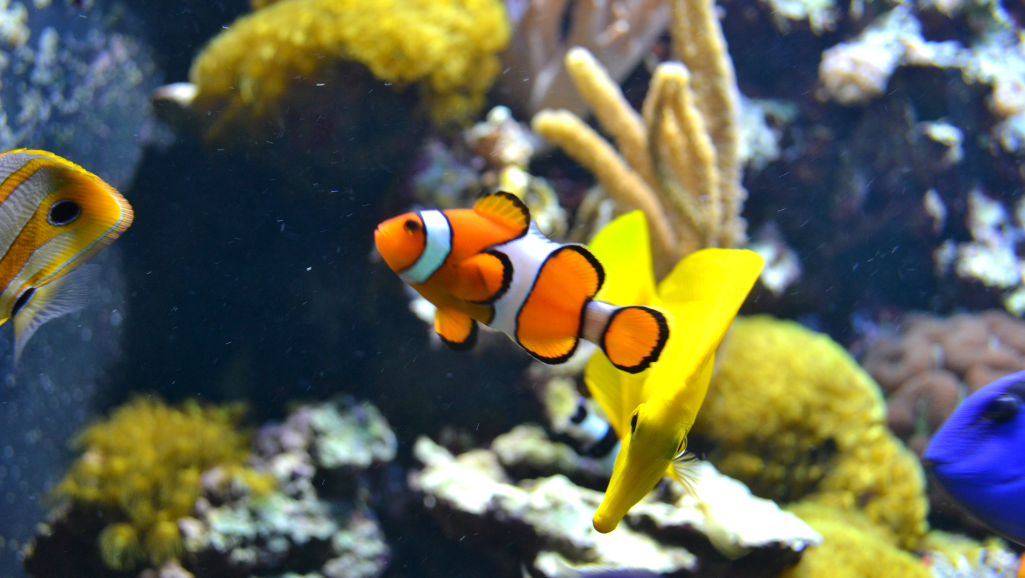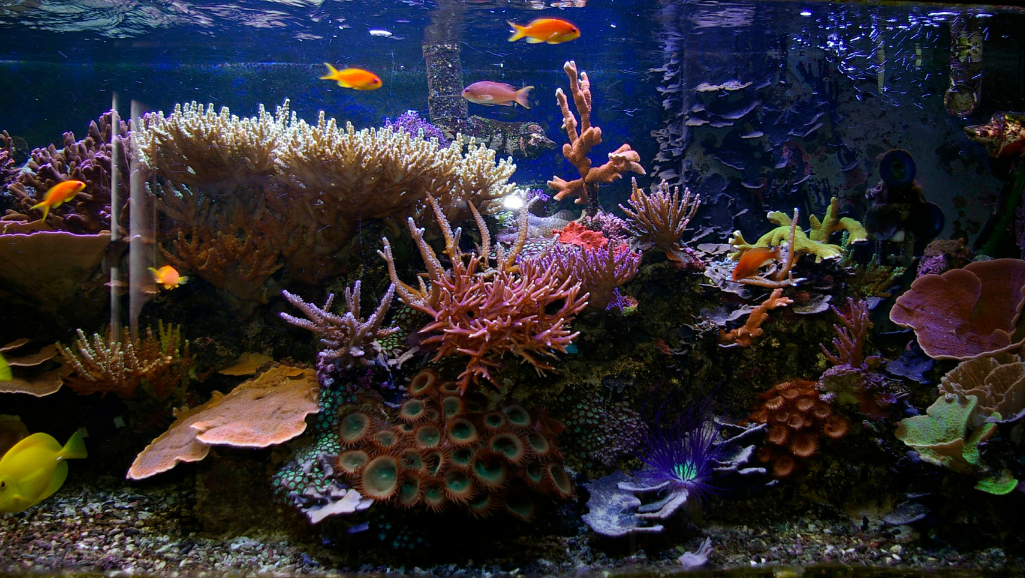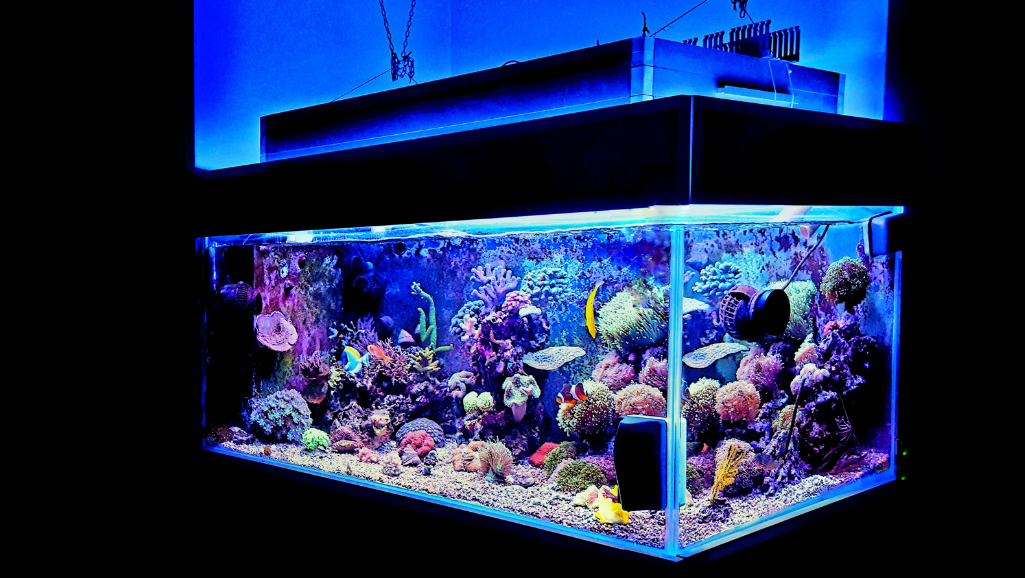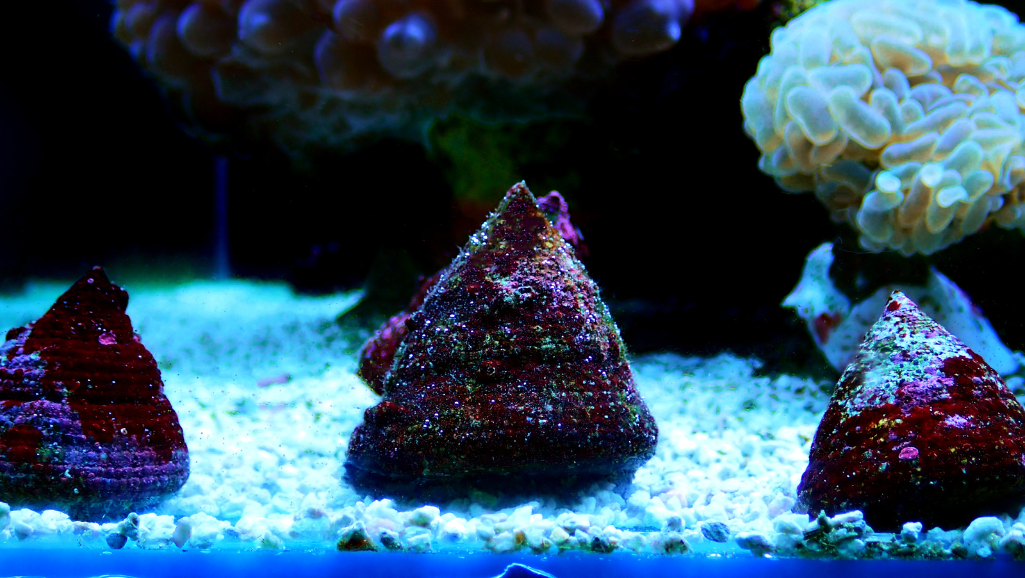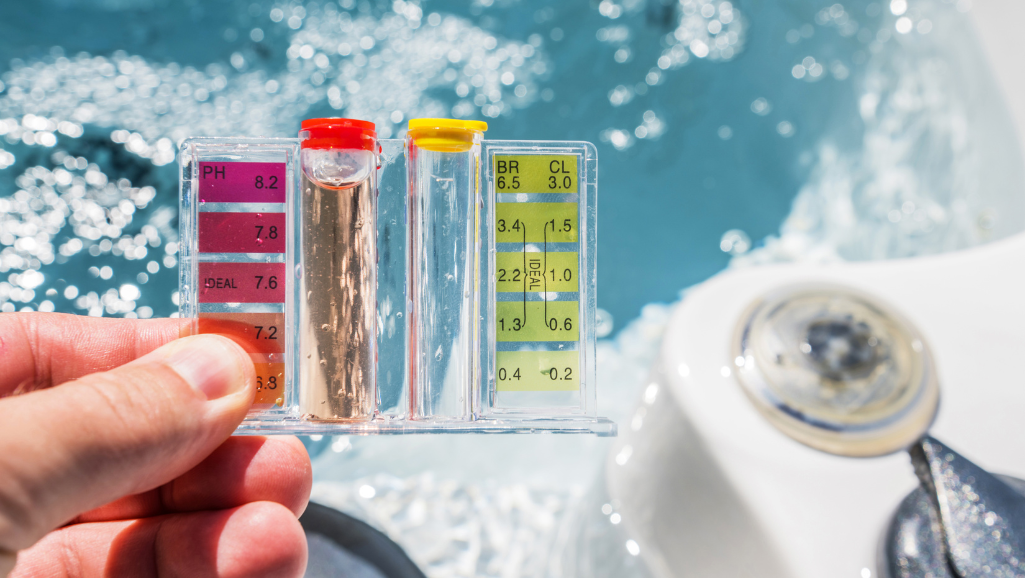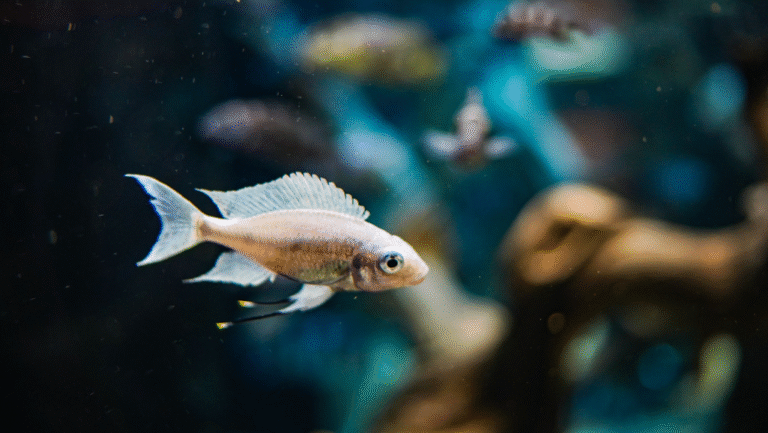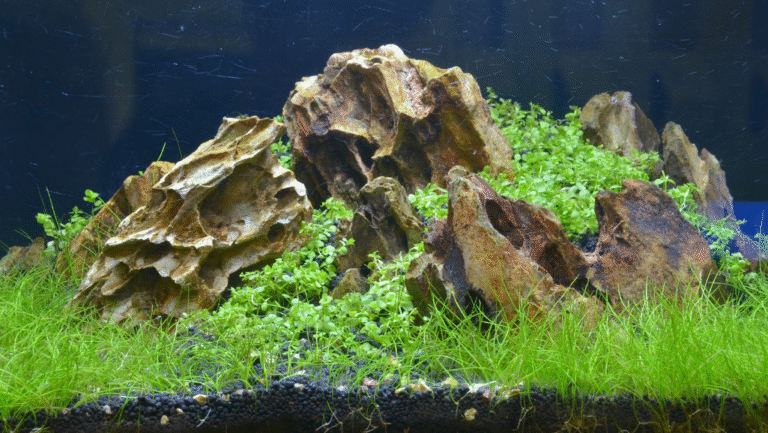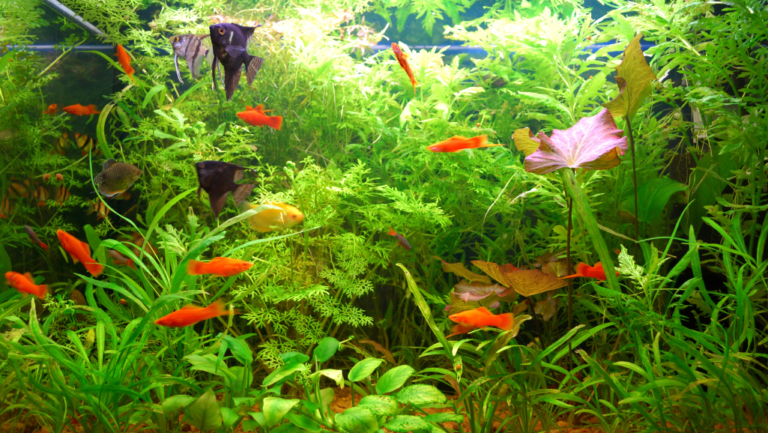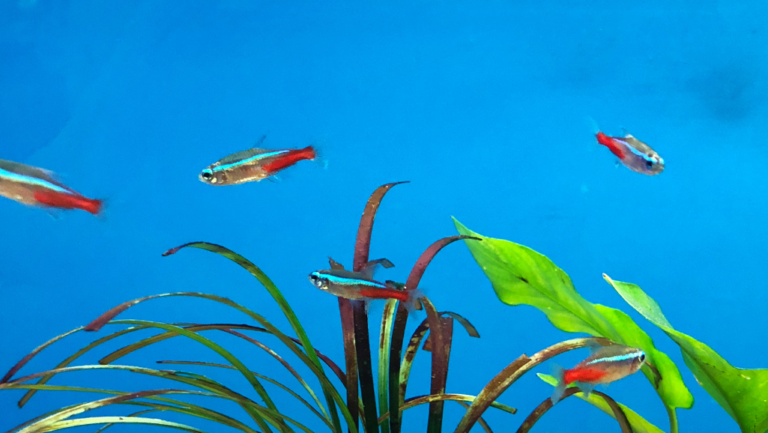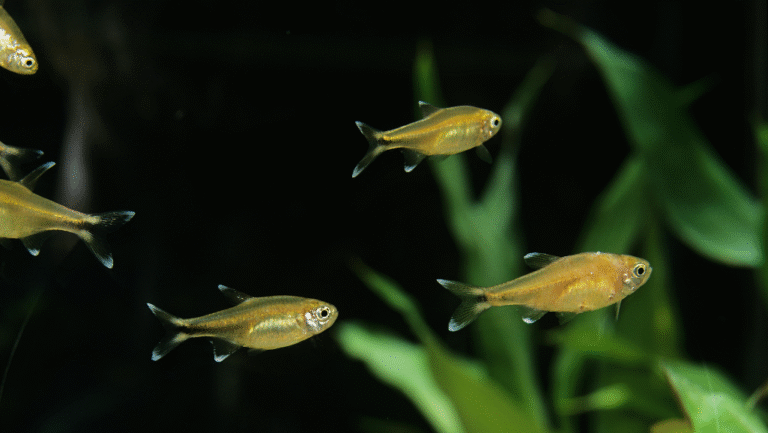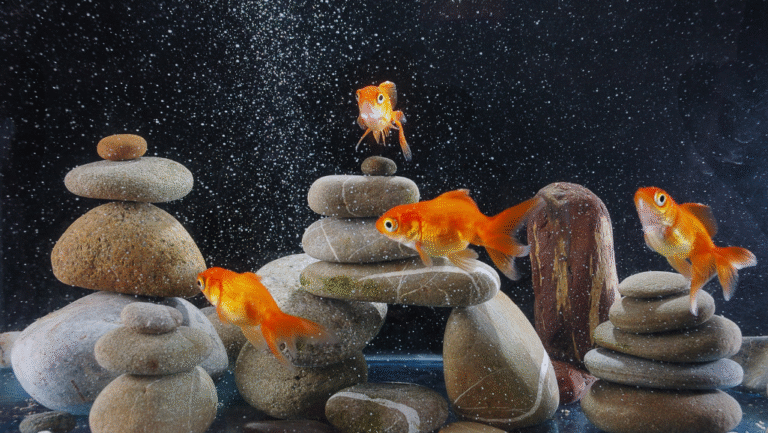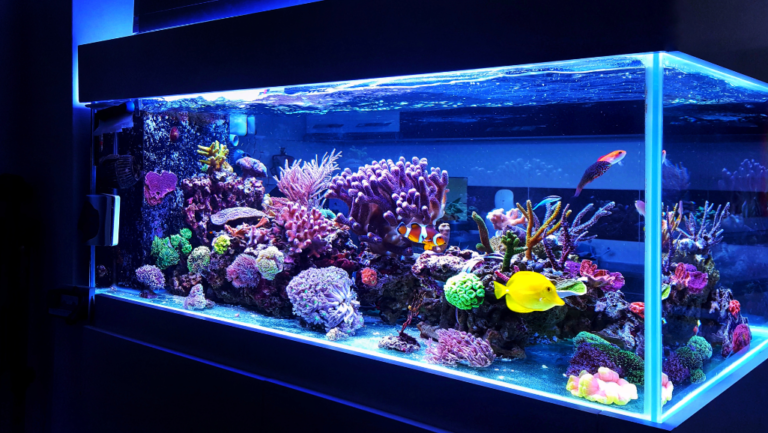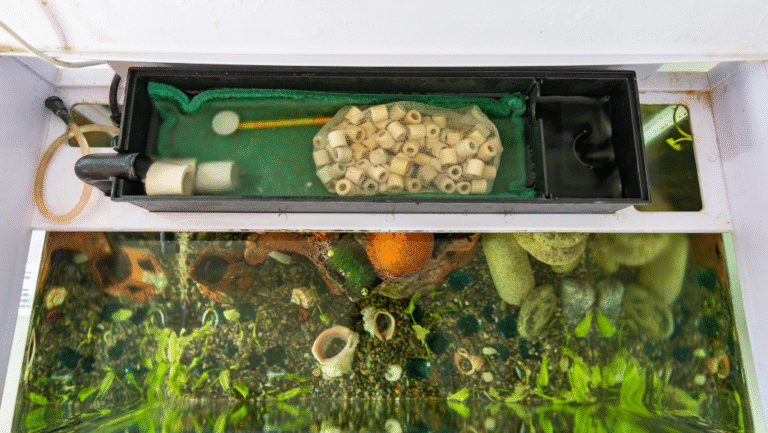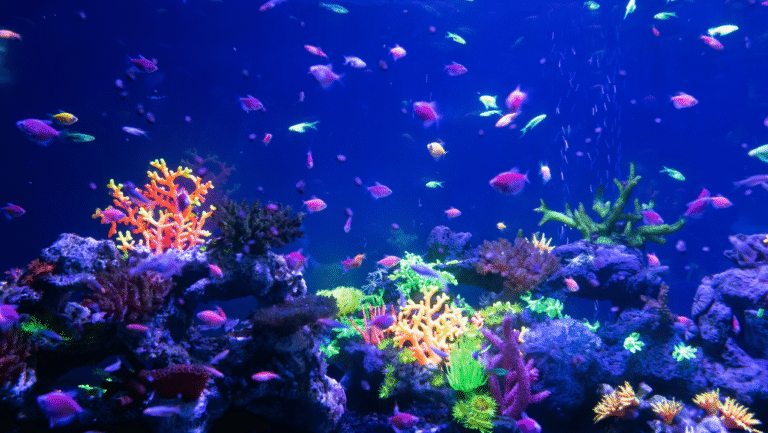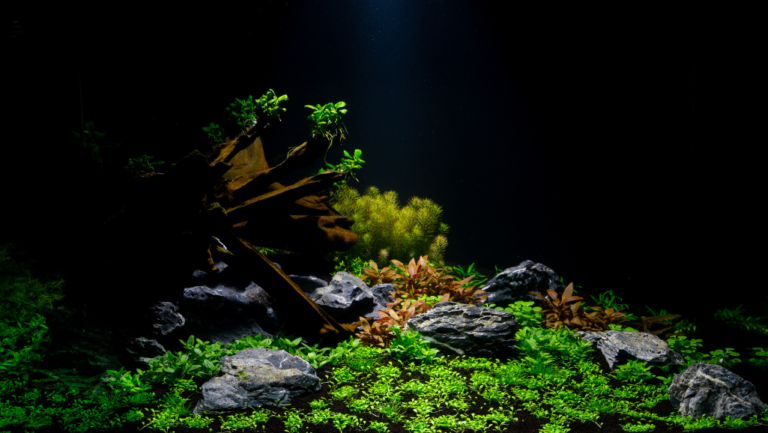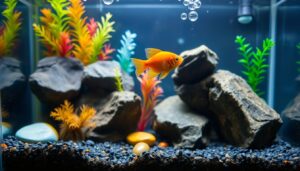Starting a saltwater aquarium is exciting, but it needs patience and knowledge of the saltwater aquarium cycle. This cycle, or nitrogen cycle, is key to a healthy marine home for fish and other sea creatures. Without it, your tank might suffer from “new tank syndrome,” leading to bad water and stressed fish.
The nitrogen cycle turns harmful ammonia from fish waste and decaying matter into safer compounds. Helpful bacteria are vital in this process. They break down ammonia into nitrite and then nitrate. Keeping these bacteria healthy is essential for your aquarium’s success.
Key Takeaways
- The saltwater aquarium cycle is vital for a healthy marine home.
- The nitrogen cycle changes toxic ammonia into safer nitrite and nitrate.
- Beneficial bacteria are key to keeping water stable.
- Proper cycling stops “new tank syndrome” and keeps your fish healthy.
- Being patient and understanding the cycle are important for aquarium success.
Understanding the Saltwater Aquarium Cycle
Setting up a saltwater aquarium means learning about the nitrogen cycle. This cycle is key to keeping your aquarium healthy. It turns harmful waste like ammonia and nitrite into safer nitrate. This is vital for a balanced and thriving aquarium.
The cycle starts with fish waste turning into ammonia. Ammonia is very harmful to fish and can cause serious health problems or even death. Luckily, beneficial bacteria like Nitrosomonas and Nitrobacter save the day. They turn ammonia into nitrite and then nitrate, which is safer for fish.
What is the Nitrogen Cycle?
The nitrogen cycle in a saltwater aquarium has three stages:
- Ammonia Stage: Fish waste and decaying matter create ammonia, which is toxic.
- Nitrite Stage: Beneficial bacteria (Nitrosomonas) change ammonia into nitrite, which is also harmful.
- Nitrate Stage: Another beneficial bacteria (Nitrobacter) turns nitrite into nitrate, a safer substance that can be removed through water changes.
Importance of Beneficial Bacteria
Beneficial bacteria are the heroes of the aquarium cycle. Without them, harmful compounds like ammonia and nitrite would build up. This would lead to poor water quality and sick fish. Having a strong population of these bacteria is essential for a healthy aquarium.
“The key to a successful saltwater aquarium is understanding and facilitating the nitrogen cycle. By nurturing beneficial bacteria and monitoring water parameters, hobbyists can create a thriving underwater world.”
When setting up your saltwater aquarium, remember the nitrogen cycle’s importance. Also, focus on growing a healthy population of beneficial bacteria. With patience and care, you’ll have a beautiful and thriving underwater world.
Key Phases of the Saltwater Aquarium Cycle
Knowing the cycling process is key to a healthy saltwater aquarium. The cycle has three main stages: ammonia, nitrite, and nitrate. Each stage brings changes to your water’s condition.
Ammonia Stage
The ammonia stage starts when you add fish or other life to your tank. Waste from them raises ammonia levels, which is toxic to fish. It’s vital to watch these levels closely. Beneficial bacteria will start to grow, turning ammonia into nitrite.
Nitrite Stage
In the nitrite stage, beneficial bacteria grow, converting ammonia into nitrite. But nitrite is also harmful to fish. So, it’s important to keep testing your water often. As the bacteria colony grows, nitrite levels will peak and then drop.
“Patience is key during the cycling process. Rushing things can lead to stress and even death for your aquarium inhabitants.”
Nitrate Stage
The nitrate stage is the final part of the cycle. Here, another type of beneficial bacteria turns nitrite into nitrate. Nitrate is less toxic but can be harmful in high amounts. Regular water changes and upkeep help manage nitrate levels.
Throughout the cycling process, it’s vital to test your water often and not add too many fish at once. By understanding and letting your aquarium go through these stages naturally, you’ll create a stable, healthy home for your marine life.
Initial Setup for Your Saltwater Aquarium
Setting up a saltwater aquarium needs careful planning and the right gear. The first step is picking the right tank size and getting the essential equipment.
Choosing the Right Tank Size
For saltwater aquariums, bigger is usually better. Larger tanks offer a more stable home for your marine friends. They can hold more fish and corals too.
Try to get a tank that’s at least 30 gallons. This size is great for better filtration and easier care. It also helps keep your aquarium healthy.
“The bigger the tank, the easier it is to maintain stable water parameters and create a thriving saltwater aquarium.”
Essential Equipment for Setup
To set up a successful saltwater aquarium, you’ll need some key essential equipment. This includes:
- A high-quality protein skimmer to remove organic waste
- A powerful filtration system to keep the water clear and clean
- Good lighting to help corals and other photosynthetic organisms grow
- A reliable heater to keep the water at a stable temperature
- A hydrometer or refractometer to check salinity levels
Buying quality equipment from the start saves you time and money. It helps avoid common problems that can come from bad setup.
Selecting the Right Substrate
Choosing the right substrate is key for a successful saltwater aquarium. The substrate is where beneficial bacteria grow. These bacteria are essential for a healthy nitrogen cycle. Let’s look at the different substrates and how they affect the cycling process.
Types of Substrate for Saltwater Aquariums
There are many substrates for saltwater aquariums, each with its own benefits and drawbacks:
- Sand: Fine-grained sand is a favorite among many. It looks natural and is good for bottom-dwellers. But, it can trap debris and needs regular cleaning.
- Crushed Coral: Crushed coral is another popular choice. It keeps the pH stable and looks natural. It also helps beneficial bacteria thrive.
- Bare Bottom: Some choose a bare-bottom setup, with no substrate. This makes maintenance easier and prevents debris buildup. But, it may not look as natural.
How Substrate Affects Cycling
The substrate you pick can greatly affect your aquarium’s cycling. Here’s how different substrates help beneficial bacteria:
Sand and crushed coral substrates offer a lot of surface area for bacteria to grow. These bacteria turn ammonia and nitrite into nitrate, helping the nitrogen cycle.
Bare-bottom setups might need extra biological filters because of the lack of substrate. Live rock and other porous materials can help grow beneficial bacteria in these setups.
No matter the substrate, keeping water parameters right and doing regular maintenance is vital. This helps your saltwater aquarium cycle healthily.
Choosing Live Rock and Its Benefits
Live rock is key to a thriving saltwater aquarium. It looks great and helps the tank cycle. It supports beneficial bacteria, making your aquarium healthy and stable.
What is Live Rock?
Live rock comes from the ocean and is full of life. It has bacteria, small animals, and algae. Made of limestone or coral, it filters your tank naturally.
How Live Rock Helps with Cycling
Live rock speeds up your tank’s cycling. The bacteria on it turn bad stuff into safe nitrate. This helps your tank start cleaning itself fast.
Live rock also homes marine life. This adds to your tank’s health and balance. It keeps algae and water problems away.
Choose good live rock from trusted places. Look for varied colors and textures. Avoid smelly or damaged rocks to keep your tank safe.
Monitoring Water Parameters
Keeping an eye on water parameters is vital for a healthy saltwater aquarium, even more so during the cycling phase. Regularly testing and tracking key parameters helps ensure your aquarium is cycling correctly. It also lets you spot any problems early.
During cycling, focus on ammonia, nitrite, and nitrate levels. Ammonia and nitrite are toxic to fish and should be near zero. Nitrate, while less harmful, should also be kept in check to prevent algae and maintain water quality.
Key Parameters to Track
Other important water parameters to watch include:
- pH: Saltwater aquariums need a stable pH between 8.1 and 8.4.
- Salinity: Keep salinity between 1.020 and 1.026 for most saltwater creatures.
- Temperature: Keep the water temperature steady, usually between 75-80°F (24-27°C).
- Alkalinity: Aim for 8-12 dKH to help buffer pH and support coral growth.
Recommended Testing Kits
To accurately measure water parameters, get high-quality testing kits. Some top picks are:
- API Saltwater Master Test Kit: Measures ammonia, nitrite, nitrate, and pH levels.
- Red Sea Marine Care Test Kits: Offers separate kits for ammonia, nitrite, nitrate, pH, alkalinity, and more.
- Salifert Test Kits: Provides precise readings for various parameters using liquid reagents.
Remember, consistent monitoring and maintenance are key to a thriving saltwater aquarium. By keeping an eye on water parameters and fixing any imbalances quickly, you’ll create a stable home for your fish to thrive.
The Role of Dechlorinated Water
Setting up a saltwater aquarium requires careful water quality. Tap water can harm your fish and upset the nitrogen cycle. This is why dechlorinated water is important.
Why Dechlorination Matters
Water treatment adds chlorine to kill bacteria. But chlorine hurts the good bacteria in your aquarium. Removing chlorine helps these beneficial bacteria, improving your aquarium’s health.
“Chlorine removal is a simple yet essential step in ensuring the success of your saltwater aquarium cycle.”
Best Methods for Dechlorinating Water
There are several ways to dechlorinate water for your aquarium:
- Use a dechlorinating agent: These products are easy to find and use. Just follow the package instructions.
- Let water sit: Leave tap water out for 24-48 hours. This lets chlorine evaporate.
- Boil water: Boiling for 20 minutes removes chlorine. Let it cool before adding it to your tank.
Using dechlorinated water helps keep your aquarium healthy. It ensures a great environment for your fish and marine life.
Introducing Fish and Livestock
After your saltwater aquarium cycles, it’s time to add fish and other sea creatures. But, make sure your tank is ready for them first. It’s important to check if your tank can support life.
Signs of a Completed Cycle
A cycle is complete when your water meets certain standards:
- Ammonia levels: 0 ppm
- Nitrite levels: 0 ppm
- Nitrate levels: Less than 20 ppm
Keeping these levels steady for days shows your tank has good bacteria. These bacteria turn harmful ammonia and nitrites into safer nitrates.
Best Fish Species for Beginners
Choosing your first fish for a new saltwater tank is important. Pick species that are easy to care for. Here are some good choices:
- Clownfish: These fish are tough and do well in tanks.
- Damselfish: Many damselfish are easy to care for and great for beginners.
- Gobies: Small, calm, and fun, gobies do well in established tanks.
“The key to success with beginner fish species is to introduce them slowly and maintain stable water parameters.”
Always acclimate your fish well and add them slowly. This helps them adjust and reduces stress. By picking the right fish and keeping your tank healthy, you’ll enjoy a thriving aquarium.
Common Mistakes to Avoid
Setting up a saltwater aquarium requires avoiding common mistakes. These mistakes can upset the balance of your tank’s ecosystem. By steering clear of these errors, you can make the cycling process smoother. This helps keep your tank healthy for your fish.
Overlooking Water Changes
Many aquarium owners forget to do regular water changes. During cycling, it’s key to change some water to control ammonia and nitrite levels. Not doing this can cause toxic buildup, harming or killing your fish.
Consistency is key when it comes to water changes. Aim to replace 10-15% of your tank’s water weekly to maintain stable water parameters.
Adding Too Many Fish Too Quickly
Another common mistake is overstocking or adding too many fish at once. Remember, your tank’s beneficial bacteria need time to grow and adapt. Adding too many fish too fast can overwhelm these bacteria, causing ammonia and nitrite spikes.
To avoid this, follow the golden rule: add fish slowly and gradually. Start with a few hardy species and wait at least a week before adding more. This lets your tank’s ecosystem adjust and stay balanced.
Ongoing Maintenance for a Healthy Aquarium
After your saltwater aquarium is set up, keeping it stable is key. Regular checks and upkeep are vital for your fish and marine life. By watching water levels and doing upkeep, you avoid problems and keep your aquarium healthy.
Regular Testing and Maintenance
Test water often for things like ammonia, nitrite, and pH. Use good testing kits and keep records. Change about 10-20% of the water every two weeks to keep it clean.
Clean the bottom, remove algae, and change filter media when needed. This keeps the water quality high.
Adapting to Changes in the Aquarium Environment
As your aquarium grows, it will change. Be ready to adjust your care routine for these changes. Watch for signs of stress or disease in your fish and corals.
Change lighting, water flow, or the types of fish if needed. Being active in your care helps your aquarium stay beautiful and healthy.
